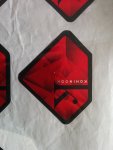manishbjain
Active member
Please find attached herewith an image of a label thats actually printed in flexo. I would like to know if the same thing is achievable in screen printing and If yes, Can it be achieved using only two special colours (Red and Black - both Half tones) . Its printed on a metallised film.














